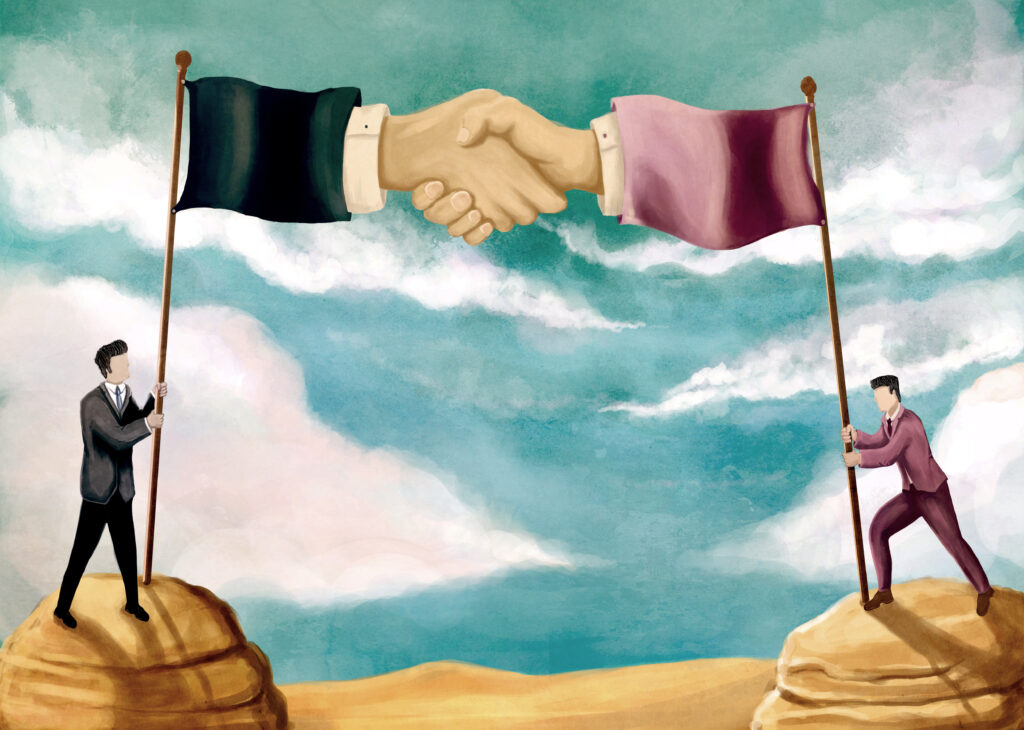
From Pharmacy to AI Healthcare Startup

In this episode, Leader's Edge hosts its third conversation at The Council's Employee Benefits Leadership Forum, with Ahmed Marmoush, co-founder and CEO of Handl Health, an AI platform that aggregates and analyzes publicly available healthcare pricing data to aid insurance brokers.
A world traveler, Marmoush discusses his life’s journey of immigrating to several countries, how he was inspired to start his business, and the intricacies of AI.
Read the Transcript
Disclaimer: Podcast transcriptions are computer generated, please excuse errors. For the most accurate version of the conversation, please refer to audio.
Ahmed Marmoush:
How does a medical bill come together? How is a claim adjudicated? How can I reliably predict an employer’s projected cost? AI enables you to feed and train models to understand what you are doing, the context that you are applying it to, and then it takes a really complex subject matter, and it turns it into generative, human, readable text.
Zach Ewell:
Hello, and welcome to the Leader’s Edge podcast. I’m Zach Ewell, market analyst and podcast producer. Last spring, I had the pleasure to host several conversations at this year’s Employee Benefits Leadership Forum in Colorado Springs. In fact, several conversations were so intriguing that we at Leader’s Edge decided to turn them into a podcast miniseries. In our third episode featuring conversations we had on the ground at EBLF, I talk with Ahmed Marmoush, CEO and co-founder of Handl Health, an AI platform that aggregates and analyzes publicly available healthcare pricing data to aid insurance brokers in growing their book of business. Marmoush shares his life’s journey of immigrating to several countries, how he got inspired to start his business, the intricacies of AI, and advice he has for young entrepreneurs.
Ahmed, thank you so much for joining me today.
Ahmed Marmoush:
Thank you for having me.
Zach Ewell:
Absolutely. We’re right here at the center of EBLF right now. A lot of people are talking, a lot of business is going on, and I’m very excited to have a conversation with you.
Ahmed Marmoush:
Yeah, we’re delighted to be here. It’s our first time here, and this is such an incredible event, so thank you.
Zach Ewell:
As I understand it, you have a degree in pharmacy.
Ahmed Marmoush:
I do.
Zach Ewell:
Did you always want to become a pharmacist?
Ahmed Marmoush:
I didn’t for a while. I wanted to be a ship captain. But my mother vetoed that. I come from a family of pharmacists. My father is a pharmacist, my mother is a pharmacist, and I have a sister who’s two years older than me who’s also a pharmacist. This was almost like a rite of passage.
Zach Ewell:
Okay. Why ship captain? I’m just interested.
Ahmed Marmoush:
New Zealand is where I call home. There’s one thing that everybody really knows about New Zealand, that it’s an island. It has 5 million people, but it’s surrounded by oceans, so we spent a lot of my upbringing on boats and enjoying the wildlife of New Zealand, particularly the ocean wildlife. Hence the reason.
Zach Ewell:
Okay, interesting. Tell me about your background, as I understand it, your family is from Egypt.
Ahmed Marmoush:
That’s right, yes.
Zach Ewell:
You’re also from New Zealand, like you said, and now you live in the U.S.
Ahmed Marmoush:
That’s right.
Zach Ewell:
You’re quite the world traveler. How did that all come to be?
Ahmed Marmoush:
Surprisingly, I was born in Kuwait. My father at the time was working for Roche Pharmaceuticals. Both my parents are, however, Egyptian, so I am Egyptian by heritage and have always been an immigrant, basically everywhere I’ve been. We immigrated to New Zealand when I was quite young, and I spent most of my life there. I did all my schooling in New Zealand.
When it came time for me to explore my professional career and ambitions, I realized that I needed to see more of the world. I had the opportunity through my prior employer to spend a bit of time in Australia initially and then in the UK for about four years. I’ve been in the US for about five years now.
Zach Ewell:
Five years. Okay. Right before COVID started.
Ahmed Marmoush:
Yes.
Zach Ewell:
This has been quite the journey.
Ahmed Marmoush:
Quite the journey. I was here for about six months and then COVID hit, and everything shut down, which was quite the experience.
Zach Ewell: That’s quite the immigration experience.
New Zealand’s healthcare system is unique and different compared to the U.S., and you are the CEO and co-founder of Handl Health. What influences and experience helped inform how you shaped and started Handl Health? Did your pharmacy degree have an influence at all?
Ahmed Marmoush: Definitely. Coming out of university, I was a clinical pharmacist for a large health system in New Zealand for some time. I was working up on the wards alongside physicians and nurses and making recommendations on treatment plans for patients. I really enjoyed that experience, but I was frustrated with working in what I considered to be a system that was quite inefficient and broken in some ways.
I went back to university and studied business and then came out of that and decided I wanted to move into consulting. I had the opportunity to join a boutique consultancy working with the former director general of the New Zealand health system, which is the highest-ranking position prior to the political position that leads the political party’s health care during that term.
Through that experience, I learned everything that I know about what constitutes running an effective healthcare system, all the way through from how do you fund care? How do you evaluate population health? What does it look like to create incentive structures for providers that drive outcomes for patients. Through that process I was fortunate enough to have, I would consider a four-year experience with that boutique consultancy which to me really shaped most of my career today.
From there, we were acquired as a firm by EY, Ernst & Young. With EY, I had the fortune to live and travel in, as well as work in, a number of different healthcare systems. I had a stint in Australia, as I mentioned, in the UK and then came to the U.S. Through that process, Australia, the UK, they do also have primarily government-sponsored healthcare.
When I came to the U.S., the reason for coming here was I had met a former EY partner in the UK, in the London office of EY, and he was sharing with me how America was embarking on their value-based medicine journey and how they were looking for expertise from folks who had worked in government-sponsored healthcare to bring some of the mindset around how you think about contracting for outcomes, how you drive the appropriate infrastructure to deliver the highest value, and access to the healthcare services that people need for the lowest cost possible.
When I came here and we started to work on this, I realized that there was this ongoing gap in how you could truly define value in the U.S. healthcare system. That is, you couldn’t get access to the true cost of care. You wouldn’t understand how much an MRI was. You couldn’t understand how much a tonsillectomy was. There was this black box that was considered commercially sensitive information and that was foreign to me. In every other health system that I had worked on, there was complete transparency around cost and quality. You knew exactly how much it cost to do anything in the system, and that’s foundational to driving any value-based medicine system.
Zach Ewell:
You describe Handl Health as an AI platform that aggregates and analyzes publicly available health care pricing data to aid insurance brokers in growing their book of business. You talked about transparency there and that totally makes sense. Tell me more about that.
Ahmed Marmoush:
Thanks to the legislation, Transparency in Coverage under the Consolidated Appropriations Act, for the first time in U.S. history, the information on the unit costs of care became publicly available. That was published under both the payer machine readable files that are now available on the payer websites, as well as the hospital machine readable files that are available on the hospitals’. What that gives you is effectively a complete picture on the cost behind networks that are available through the carriers today.
The challenge, however, is that data is huge. It has a ton of noise in it and it’s difficult for the average person to take that information and make it usable, specifically in the employee benefits world, which is where we’re focused. That’s a perfect use case for AI. We’re taking it and applying it to a large data set so it can learn some of the quirks of it and help us with making this information usable.
How we translate that into something that can support the employee benefits consultants we work alongside of is traditionally—prior to the Transparency legislation, the way in which both, networks were selected on behalf of self-insured employers or even fully insured employers, and how benefits were designed to make the best use of the different providers from a cost and quality standpoint—never really considered unit cost.
What we’ve really been able to do is equip brokers with a different type of analytics and predictive modeling tool that helps them have an independent and objective view of the true cost of services. You can roll that up and understand the true cost of a network, because a network is essentially a set of contracts where they have prices for specific services.
It’s presented, from my perspective, an opportunity to really think creatively around how consultants can provide the type of advice that self-insured employers need when thinking about how to drive cost containment, while also enabling the best access to healthcare and the best outcomes for people.
I often joke about this, that my experience in government-sponsored healthcare parlays really nicely into the sector. If you think about it, governments and employers have a lot in common when it comes to looking after their people. They want to keep their people as productive and as healthy as possible for as long as possible. They want to do it for the lowest cost possible because ultimately it comes out of their bottom line.
Zach Ewell:
There’s a lot of incentives there that are matched. Could you give me a simple but specific example of how your platform could assist a broker or their clients?
Ahmed Marmoush:
Definitely. One example that I can think of is a client of ours who was going through a finalist presentation with a prospect. This prospect was a national client. They had a footprint across the U.S., and they were evaluating different networks that were right for them. What this broker was able to do was, alongside their traditional discount analyses that they were able to run, they were able to use the Handl platform to present an independent and objective view of the network performance. Not only at a discount level, going beyond just the discount, and actually starting to look at the specific clinical diagnoses or categories that the employer had shared with them around high-cost claimants and what they were using most often, but also down to the specific hospital and providers that they were using.
What you see in the data is that the discounts, they hide the spread. They hide the spread of cost. When you’re using a platform like Handl, you can start to get really intelligent and granular about the type of network that you’re recommending, based on the employer and the specific hospitals that their employees are going to, as well as the specific diagnoses that their employees have.
Through that process, the broker was able to highlight this as part of their finalist presentation and was successful in winning the broker record designation.
Zach Ewell:
You’ve mentioned AI several times. Every company now uses AI.
Ahmed Marmoush:
The buzzword.
Zach Ewell:
The buzzword, but it’s very impactful, I’d argue more than blockchain. That was the buzzword a couple of years ago, right before COVID. This is more of a broad question. In terms of utilizing AI, can you take me through just a very simplistic process? Was it just a problem and an idea, or was it you messing around with AI or a specific application? How did you get inspired to use AI as a way to assist your application?
Ahmed Marmoush:
The way I think about it is traditional programming is very much human led. It has to be led by the engineer that has the idea to drive the innovation. What AI enables you to do is access a ton of information and use what they call officially a “neural network” to start to make recommendations, using computers, to help you with thinking through intractable problems that may not have been solvable by just one engineer or two engineers, but maybe took hundreds.
The application of AI in our world is very interesting because we’re dealing with big data, which we know there are a ton of use cases for. But more so than that, we’re dealing with very complicated information. I often joke about the fact that to interpret this information, you need to be an actuary, you need to be a billing code expert, and you also need to be a claims adjudication expert to really understand how does a medical bill come together? How is a claim adjudicated? How can I reliably predict an employer’s projected cost based on this information? AI enables you to feed and train models to understand what you are doing, the context that you are applying it to, and then it takes a really complex subject matter, and it turns it into generative, human readable text.
Some of the exciting things that we have on the horizon are, imagine a copilot for a benefits consultant or broker that works alongside them as they are evaluating networks, as they are reviewing claims experience of their clients, as they are making recommendations on the right type of health plan to construct on behalf of their prospect or client.
AI can make a very difficult subject matter, something that you could generate a number of scenarios or recommendations based on what you, as the broker and your client are prioritizing, in terms of the most important things, whether that’s cost, whether that’s access, whether that’s competitive differentiation. That’s where I think there’s a ton of really exciting opportunity.
Zach Ewell:
That’s a great way of breaking it down. I like your example also of exciting stuff on the horizon. We talk about AI agents, but in this, it sounds like a copilot that would essentially assist health and benefits consultants.
Let’s say one teacher is trying to teach one subject to 30 kids. Those 30 kids are only going to retain so much subject versus a single tutor has the power to educate a child or a person at a much more successful and faster pace. That’s what it seems like the direction you’re headed in. A great application for AI as well.
Ahmed Marmoush:
That’s a perfect analogy. It’s this idea of having a counterpart that can assist you throughout your learning journey or whatever work you need to complete, that’s exactly right.
Zach Ewell:
My last question. You’re an entrepreneur. Do you have any advice on entrepreneurs looking to break into the health care or insurance space?
Ahmed Marmoush: If I could repeat my journey again is the key here. The insurance industry, the healthcare industry needs more entrepreneurs. For the folks out there who are listening that are considering it, my recommendation is please jump into the deep end and give it a go. As you do that, there are some nuances to understand about the insurance and the health tech space, and that comes down to understanding the relationships that really drive this business.
One of the things that I initially overlooked when I started this is the power of relationships and, when it comes to making high-cost decisions, how significant relationship building is, investing in people and the time to understand people. I don’t think you can undervalue the importance of spending time with prospects, clients, and understanding the problems they face, and really learning them in an intricate level of detail so you can learn to best serve their needs.
The other piece is entrepreneurs, especially in tech, are always looking at how to build the best product. There’s this concept of product market fit: Are you solving a real problem that people have and does your product actually create an ROI, which I think is really important. There’s a key part to that I think is missing, which is product market sales fit.
One of the biggest things that folks who are considering entering the space need to understand is the sales process of working alongside insurance and healthcare systems and understanding the motivations and incentives behind the economic buyers, because those don’t always line up to what you think they might be when you’re building product. Understanding your distribution model, and the industry that we’re in, in the employer-sponsored healthcare market, the channels of distribution are multifaceted. The way upon which you can reach your end buyer is vast. Being able to be very deliberate around which path you choose to go and having an understanding as to why you’re doing that is going to be the key to successfully gaining the traction you need to sell in this industry.
Zach Ewell:
That was my conversation with Ahmed Marmoush, CEO and co-founder of Handl Health. I hope you enjoyed listening to it. To listen and subscribe to Leader’s Edge podcasts, go to leadersedge.com or wherever you get your podcasts.




